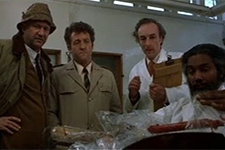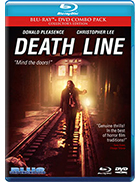Death Line (aka Raw Meat)
|  Empty subway stations are among the creepiest of urban locations, which makes it surprising that director Gary Sherman’s Death Line was one of the first horror films to use the dark sprawl of an underground mass transit system as a primary setting for grisly horrors. Sure, there had been plenty of horror movies that took place underground, starting as early as The Phantom of the Opera (1925) with its subterranean lair beneath the Paris Opera House, but the unique disquiet of the modern subway system had been left largely untouched prior to Sherman’s low-budget early-’70s gem of rough-hewn claustrophobic horror. The screenplay, which was penned by commercial producer Ceri Jones from a story he concocted with Sherman (with whom he had been collaborating on a series of Proctor & Gamble commercials), uses as its wellspring the time-honored legend of a group of people creating their own twisted, inbred society in isolation from the rest of the world. In this case, it is a group of 19th-century tunnel workers who were digging beneath London to create the Metropolitan Railway (later the London Underground) when the roof collapsed, trapping them deep underground. The company digging the tunnel was in financial straits and eventually went bankrupt, which meant no search-and-rescue effort was made and they were assumed dead. Unbeknownst to millions of Londoners over the next century, those workers survived and apparently bred, although by the time of the film’s setting in the early 1970s, only two warped, cannibalistic descendants survive: a man (Hugh Armstrong) and a woman (June Turner), the latter of whom dies, presumably during a failed childbirth, leaving the already mumbling, violent man distraught and bereaved. Interestingly, despite his nonsensical guttural language, festering sores, and generally sordid appearance, the man is strikingly sympathetic even as he plays the role of the villain, which makes Death Line a much more emotionally complex experience than one might expect. The man is as much victim as he is perpetrator, damned to an existentially deformed existence that maintains the fundamentals of human emotion (sadness, anger, lust), but little else. He’s like a feral animal, so it’s no wonder that he is prone to swiping victims from deserted subway platforms, not just for food, but to exact vengeance for his own pathetic being. We aren’t introduced to the man until a good half an hour into the film, although his off-screen presence is suggested in the opening sequence in which he accosts a perverted British official named James Manfred (James Cossins) in the empty Russell Square tube station. Manfred’s unconscious body is discovered by two students, an American named Alex (David Ladd) and his British girlfriend Patricia (Sharon Gurney), sprawled on the steps leading out of the station. Alex assumes he is a passed-out drunk and, like any good Nixon-era New Yorker, wants to just leave him there, while Patricia worries that he might be a diabetic or someone who had a heart attack. They fetch a policeman, but when they return to the stairwell, the body is gone. The case goes to the eccentric Inspector Calhoun (Donald Pleasance) and his colleague Detective Sergeant Rogers (Norman Rossington), who quickly tie the event to a series of disappearances at that same tube station. Because Manfred was a high-ranking official in the British Defense Department, Calhoun’s investigation is stymied by a belligerent member of MI5 (Christopher Lee), although he is hardly deterred from trying to discover what happened. It all leads, of course, into the bowels of the London Underground, whose abandoned and unfinished tunnels provide copious space for all manner of perversity to fester, an idea that is hardly new. As I noted in my review of C.H.U.D. (1984), a low-budget American horror film that owes some debt to Death Line, there were stories about ferocious black pigs breeding in London’s sewers in the 1800s and urban legends about alligators living in Manhattan’s sewers dating back to the 1920s. It isn’t much of a stretch to imagine the subterranean world of sewer, subway, and access tunnels being home to terrible things, and Sherman gives this idea a perfectly tuned visual treatment midway through the film when he introduces the man and his underground lair in an eight-minute circular tracking shot that begins with a close-up of a dismembered, gnawed human arm and tracks across several decomposing corpses before moving out and down a long tunnel that connects this unseen lair of horrors to the everyday world above. As critic Robin Wood perceptively noted in his review of the film in London’s Monthly Film Bulletin in 1972, “The core of the film is contained in that shot; the meaning is essentially created by the technique. The circular movement of the camera in a constricted space … creates the claustrophobia of this appalling world, both prison-cell and womb. The scene communicates—from the hideous conditions, the permanent entrapment, the subterranean location—the idea of Hell…” Death Line was a substantial hit across Europe in 1972, and many critics (like Robin Wood) recognized the effectiveness of both its gruesome horror moments and its tension-relieving humor. Other critics were not so kind: The Washington Post’s Tom Shale reserved some of his most pointed invective for the tracking shot that Wood found so compelling (“Sherman’s idea of suspense-making is to pan for five minutes around the tunnel and then settle his camera on a pile of rocks”), and Roger Ebert focused on the film’s general unevenness, especially in terms of the acting. While Pleasance (still a few years away from his iconic role in John Carpenter’s Halloween) and Rossington (who was so good as the straight man to the Beatles in A Hard Day’s Night) are excellent, mixing stolid British professionalism with goofy humor, David Ladd is almost embarrassingly stiff, especially when playing opposite Pleasance. In another film Christopher Lee’s presence would be most welcome, but here he is oddly used in an almost throwaway role that suggests, but doesn’t really do much with, the insidiousness of government secrecy and power (not surprisingly, the scene was added after the script was completed strictly as a means of involving Lee, which is why it feels so oddly out of place with the rest of the film). The film’s U.S. distribution rights were snapped up by exploitation impresario Samuel Z. Arkoff’s American International Pictures (AIP), which rechristened it Raw Meat and marketed it with an attention-grabbing one-sheet featuring a group of demonic-looking characters that appear nowhere in the film. It didn’t do well in the U.S., and for a number of years slipped out of the public consciousness. However, its impact on the horror genre is clear, which we can see in subsequent films that have served up all manner of terror in various subway tunnels and stations—from the mutated creature stalking Franka Potente in the London subway in Creep (2004), to the river of evil slime flowing through New York’s underground in the comical Ghostbusters II (1989). Director Gary Sherman, who was born in Chicago but had been working in the commercial industry in London for several years, makes the most of his limited location by emphasizing the decrepit and claustrophobic qualities of both the gleaming tiled subway stations and the dank tunnels that disappear into the dark. He would go on to direct the zombie shocker Dead & Buried (1981), the Rutger Hauer action vehicle Wanted: Dead or Alive (1987), and the ill-received Poltergeist III (1988), although he has also remained active in documentary work, which is where he actually started his career (his debut was the 1966 short television documentary The Legend of Bo Diddley). His work here suggests a filmmaker who is able to transcend the limitations of his material, turning a potentially ludicrous story into a film that is both unsettling and quite funny, often at the same time.
Copyright © 2017 James Kendrick Thoughts? E-mail James Kendrick All images copyright © Blue Underground | |||||||||||||||||||||||||||||||
Overall Rating: 

 (3)
(3)


